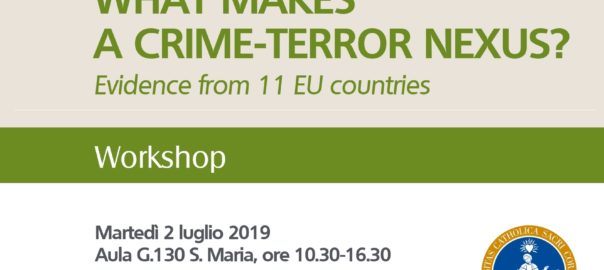Today at Università Cattolica in Milan we were glad to host the workshop “What makes a crime-terror nexus? Evidence from 11 EU countries”.The event is in the framework of the research “From Criminals to Terrorists and Back?”[1], developed by Globsec in partnership with the Italian Team for Security, Terroristic Issues and Managing Emergencies (ITSTIME)[2], the Universidad Rey Juan Carlos, the Universiteit Leiden, the University College Cork and the Institut de Relations Internationales et Strategiques (IRIS), and with the aim of seeking to determine whether the crime-terror nexus actually exists and investigating which types of criminality might be antechambers to terrorism. It specifically focuses on the profiling of hundreds of individuals from 11 EU countries, arrested in 2015 and convicted of terrorism offences before 31 December 2018[3], mostly through data coming from open sources.
The workshop benefited from the active participation of more than 20 outstanding experts coming from the academia and Italian institutions such as the Ministry of Interior, the Ministry of Justice, Carabinieri and the prefecture of Milan.
The morning session opened with the presentation of the wider EU picture by Martina Babíková and Viktor Szucs from Globsec, discussing the comparative analysis of 11 member states and putting forward the following interesting findings:
- 1/3 of European jihadis had record of previous criminal arrest;
- They finance their terror activity by legal means;
- These are not just petty criminals – there are serious or repeated criminal offenders among European jihadis;
- There is no clear pathway between crime and terrorism.
The stage was then left for Giovanni Giacalone from ITSTIME who presented the Italian situation[4], based on the analysis of around 60 profiles and highlighting that:
- Convicts were mostly young, foreigners, low educated and with unstable employment;
- Arrests were mainly concentrated in north and central Italy;
- Only 7 of the analysed convicts had some sort of criminal past, showing a no strong crime-terror nexus.
Following the presentations, a fruitful discussion started among the participants whose confronted the complexity of the topic (crime-terror nexus), the limitations of the research, the peculiarity of the Italian case and the need to boost cooperation between institutions and the academia.
In the afternoon Italy was at the centre and the discussion turned toward specific issues such as the possible relationship between the Italian organized crime and terrorist organizations/individuals, the role of self-proclaimed spiritual guides in prison and the primary importance of countering radicalization. Suggesting to progressively shift the focus from facts (attacks) to individuals also.
At the end, the overall benefit brought about by the research was again recognized and welcomed. Moreover, new interesting horizons toward which to head the possible future development of the “From Criminals to Terrorists and Back?” enterprise were also advanced, placing particular attention to:
- Go beyond 2015;
- Other forms of terrorism;
- Diverse socio-cultural contexts;
- The possibility to obtain indicators of radicalization.
[1] https://www.globsec.org/projects/criminals-terrorists-back/
[2] https://www.itstime.it/w/globsec/
[3] https://www.globsec.org/wp-content/uploads/2017/12/Crime-Crime-Terror-Nexus-update.pdf
[4] https://www.globsec.org/wp-content/uploads/2018/05/From-Criminals-to-Terrorists-and-Back-Quarterly-Report-2018-Italy.pdf

